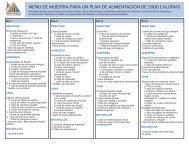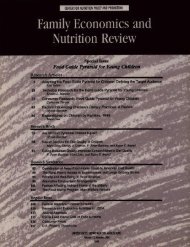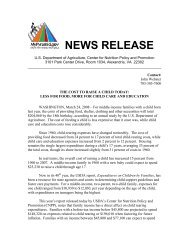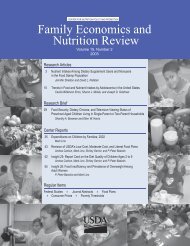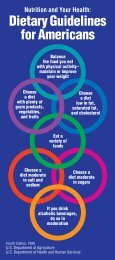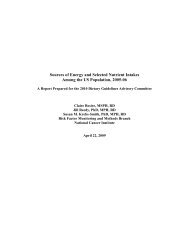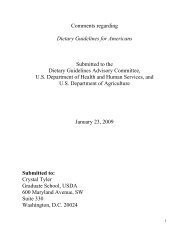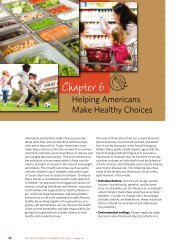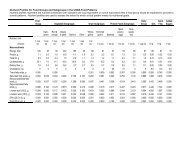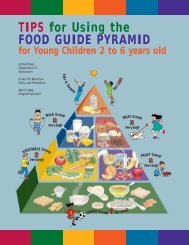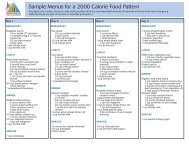Elderly Nutrition - Center for Nutrition Policy and Promotion - US ...
Elderly Nutrition - Center for Nutrition Policy and Promotion - US ...
Elderly Nutrition - Center for Nutrition Policy and Promotion - US ...
Create successful ePaper yourself
Turn your PDF publications into a flip-book with our unique Google optimized e-Paper software.
Method<br />
Data <strong>and</strong> Sample<br />
The CSFII 1994-96 is a nationally<br />
representative sample of individuals<br />
of all ages living in the United States.<br />
In<strong>for</strong>mation regarding food <strong>and</strong><br />
nutrient intakes of each respondent<br />
was gathered over 2 nonconsecutive<br />
days by using dietary recalls.<br />
Individuals age 20 <strong>and</strong> older also<br />
completed the DHKS, which contains<br />
in<strong>for</strong>mation regarding the dietary<br />
health knowledge <strong>and</strong> attitudes of each<br />
individual. Included are questions<br />
about the knowledge of specific health<br />
risks associated with foods, personal<br />
health in<strong>for</strong>mation, <strong>and</strong> the frequency<br />
of use of in<strong>for</strong>mation on food labels.<br />
The DHKS sample consists of 5,765<br />
respondents, from which 732 single<br />
women age 65 <strong>and</strong> older residing in<br />
rural (n=218) <strong>and</strong> nonrural (n=514)<br />
areas were selected <strong>for</strong> this study.<br />
The method used to collect the dietary<br />
recall in<strong>for</strong>mation in these surveys may<br />
lead to underreporting, particularly<br />
among older participants. It could also<br />
place some participants’ nutritional<br />
status below the U.S. Recommended<br />
Dietary Allowance (RDA) threshold<br />
<strong>for</strong> one or more of the specific components<br />
of nutritional adequacy considered<br />
in this study (Dixon, Cronin,<br />
& Krebs-Smith, 2001). Un<strong>for</strong>tunately,<br />
it is not possible to ascertain the extent<br />
to which underreporting might be a<br />
problem <strong>for</strong> the sample used in this<br />
study. Thus, the possibility of underreporting<br />
is simply acknowledged as<br />
a limitation of these data.<br />
Conceptual Framework<br />
The Deacon <strong>and</strong> Firebaugh (1988)<br />
systems model of resource management<br />
provides the basic conceptual<br />
framework used in this study. According<br />
to this model, through the managerial<br />
actions of planning <strong>and</strong> implementing,<br />
resources are trans<strong>for</strong>med in<br />
ways that meet value-based goals. In<br />
the trans<strong>for</strong>mation process, constraints<br />
<strong>and</strong> facilitating conditions can be<br />
present. Constraints limit means of<br />
reaching a goal or restrict access to<br />
or use of resources. Facilitating<br />
conditions, in contrast, ease the<br />
process of goal attainment.<br />
When this conceptual framework is<br />
applied to the current study, the goal<br />
to be met is obtaining adequate<br />
nutrition—defined as intake of given<br />
nutrients that meet or exceed the<br />
RDAs. Resources consist of level<br />
of education, nutrition knowledge,<br />
income (measured as a percentage of<br />
the poverty level), <strong>and</strong> receipt of food<br />
stamps. Attitudes <strong>and</strong> behavior related<br />
to food procurement <strong>and</strong> preparation<br />
comprise the managerial actions of<br />
planning <strong>and</strong> implementing. Several<br />
factors could help or constrain<br />
obtaining adequate nutrition. For<br />
example, diet restrictions <strong>and</strong> disease<br />
can constrain food choices; work<br />
commitments can constrain time <strong>for</strong><br />
food shopping <strong>and</strong> preparation; rural<br />
residence can limit access to less<br />
expensive, higher quality foods,<br />
which raises the costs associated with<br />
obtaining adequate nutrition. Taking<br />
a daily multivitamin/multimineral<br />
would facilitate meeting the RDAs <strong>for</strong><br />
vitamins <strong>and</strong> minerals. Other variables<br />
in the conceptual framework are age,<br />
race, <strong>and</strong> region of residence, which<br />
enter the model as controls.<br />
Empirical Model<br />
To ascertain the importance of the<br />
factors considered in this study,<br />
we used an ordinary least squares<br />
regression to compute st<strong>and</strong>ardized<br />
betas:<br />
RDA index = α + Σβ ii resources + Σβ ii<br />
management + Σβ ii constraining<br />
factors + Σβ ii facilitating factors + ε<br />
An RDA index was constructed to<br />
measure the degree to which study<br />
participants met RDA requirements <strong>for</strong><br />
food energy, protein, <strong>and</strong> 14 essential<br />
vitamins <strong>and</strong> minerals. The threshold<br />
level <strong>for</strong> each component of the index<br />
is based on the 1989 RDAs (National<br />
Academy of Sciences, 1989). These<br />
RDAs were used rather than the<br />
recently published Dietary Reference<br />
Intakes (DRIs) because the RDAs were<br />
current at the time the data used in this<br />
study were collected.<br />
Resources consisted of measures of<br />
both general <strong>and</strong> nutrition-specific<br />
knowledge <strong>and</strong> economic resources.<br />
General knowledge was measured by a<br />
set of categorical variables indicating<br />
highest grade completed. <strong>Nutrition</strong>specific<br />
knowledge was measured by<br />
the number of items from a total of<br />
13 that a study participant answered<br />
correctly on a test of nutrition knowledge<br />
administered in the original<br />
survey. Economic resources consisted<br />
of income, which was measured as a<br />
percentage of poverty <strong>and</strong> receipt of<br />
food stamps.<br />
Attitudes <strong>and</strong> behavior related to food<br />
procurement <strong>and</strong> preparation were<br />
indicative of plans <strong>and</strong> actions<br />
associated with achieving nutritional<br />
adequacy (management). Whereas<br />
attitudes were indicated by the<br />
importance of nutrition, proper food<br />
storage, ease of preparation, <strong>and</strong> taste,<br />
behavior was denoted by study<br />
participants’ use of nutrition labels<br />
<strong>and</strong> whether they had the main<br />
responsibility <strong>for</strong> preparing meals.<br />
Constraints on food choices were<br />
measured by the presence of diet<br />
restrictions <strong>and</strong> diseases prevalent<br />
among the elderly. These consisted<br />
of lowfat, low-calorie, low-sodium,<br />
high-fiber, or diabetic diets <strong>and</strong><br />
circulatory disease, diabetes, cancer,<br />
or osteoporosis. Work was considered<br />
a time constraint to shop <strong>for</strong> <strong>and</strong><br />
prepare food. Although incidence of<br />
employment among the elderly is low,<br />
76 Family Economics <strong>and</strong> <strong>Nutrition</strong> Review



